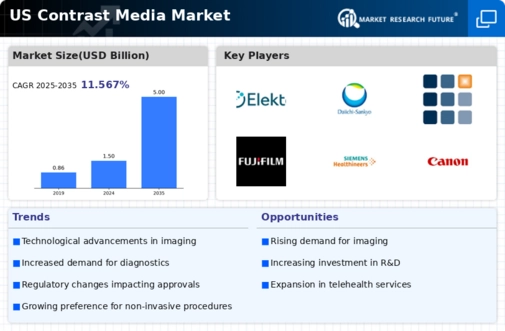Expansion of Outpatient Imaging Centers
The proliferation of outpatient imaging centers in the US is a significant driver for the contrast media market. These facilities offer convenient access to diagnostic imaging services, catering to the growing demand for timely and efficient healthcare. As outpatient centers continue to expand, they are likely to increase the volume of imaging procedures performed, which in turn will elevate the need for contrast agents. Recent trends indicate that outpatient imaging services are becoming increasingly popular due to their cost-effectiveness and shorter wait times compared to traditional hospital settings. This shift towards outpatient care may create new opportunities for growth within the contrast media market, as these centers adopt advanced imaging technologies and enhance their service offerings.
Increasing Prevalence of Chronic Diseases
The rising incidence of chronic diseases in the US is a pivotal driver for the contrast media market. Conditions such as cardiovascular diseases, cancer, and neurological disorders necessitate advanced imaging techniques for accurate diagnosis and treatment planning. According to recent statistics, chronic diseases account for approximately 70% of all deaths in the US, highlighting the urgent need for effective diagnostic tools. As healthcare providers increasingly rely on imaging modalities like MRI and CT scans, the demand for contrast agents is expected to surge. This trend indicates a robust growth trajectory for the contrast media market, as healthcare systems adapt to the growing burden of chronic illnesses and seek innovative solutions to enhance patient outcomes.
Growing Awareness of Preventive Healthcare
Increasing awareness of preventive healthcare among the US population is driving demand for diagnostic imaging. This, in turn, impacts the contrast media market. As individuals become more proactive about their health, there is a notable rise in routine screenings and diagnostic tests. This trend is supported by initiatives aimed at promoting early detection of diseases, which often require the use of contrast agents for accurate imaging. The emphasis on preventive care is likely to result in a higher volume of imaging procedures, subsequently boosting the demand for various contrast media. This shift towards preventive healthcare suggests a positive trajectory for the contrast media market, as it aligns with broader public health goals.
Rising Investment in Healthcare Infrastructure
Ongoing investment in healthcare infrastructure in the US is a crucial driver for the contrast media market. As hospitals and diagnostic centers upgrade their facilities and expand their imaging capabilities, the demand for high-quality contrast agents is expected to rise. Recent reports indicate that healthcare spending in the US is projected to reach $6 trillion by 2027, with a significant portion allocated to advanced imaging technologies. This influx of capital is likely to enhance the availability and accessibility of diagnostic imaging services, thereby increasing the utilization of contrast media. The expansion of healthcare facilities and the integration of state-of-the-art imaging equipment may create a favorable environment for the growth of the contrast media market.
Technological Innovations in Imaging Techniques
Technological advancements in imaging modalities are significantly influencing the contrast media market. Innovations such as 3D imaging, hybrid imaging systems, and artificial intelligence integration are enhancing the capabilities of diagnostic imaging. For instance, the introduction of advanced MRI techniques has improved the visualization of soft tissues, leading to better diagnostic accuracy. The market for contrast media is projected to expand as these technologies become more prevalent in clinical settings. Furthermore, the increasing adoption of minimally invasive procedures is likely to drive the demand for specific contrast agents tailored for enhanced imaging. This evolution in imaging technology suggests a promising outlook for the contrast media market, as it aligns with the growing emphasis on precision medicine.

















Leave a Comment